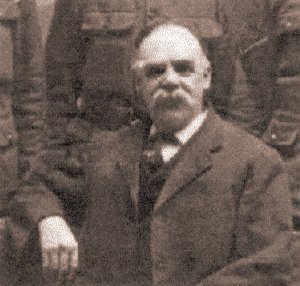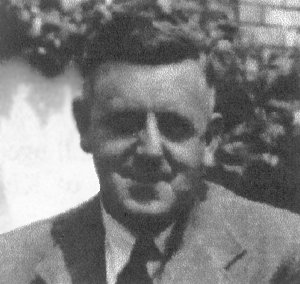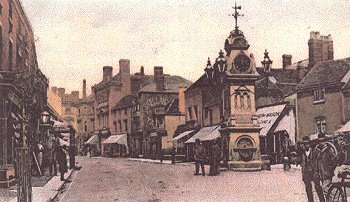Part Three
| Daniel's
middle son, Daniel (fourth generation and aged 60) along with
his wife were living at 26 Newcomer Street, London. He was
employed as a lock maker. However, his son Daniel, (aged 35) was
still living in Willenhall with his family in Regent Street. He
was employed as a mortise lock maker. Daniel's youngest son,
George, (fourth generation) had moved from Southwark, London to
Basildon, Essex, where he had become a lock manufacturer. He was
described as a Locksmith on the 1901 Census and an employer,
working at home. |
|

George
Worrall
|
George
Worrall (my grandfather), and his brother, Thomas, began a
partnership where George made the keys and Thomas the locks.
(Thomas, their father, had died about the same time as their
Uncle Thomas). The partnership finished when George's wife died
in 1897 leaving him with seven children, including a baby of
four months. George then became a Journeyman Locksmith. By 1901
he had remarried and had another child and was living at 4 John
Street, Willenhall. |
| Thomas,
was a Padlock Manufacturer in 1901. He was an employer, working
at home, 18 Walsall Road, Willenhall. At that time, he had three
daughters and one son, Harold. He later had two more sons, Frank
and Ernest (Ernie), who worked in the family business. In the
1900s Thomas and his sons moved their business to Lower
Lichfield Street and later to Doctor's Piece, where they
manufactured locks until the business was sold in 1974.

|
|
When
Thomas died, circa 1927, he willed everything to his widow,
Elizabeth, and on her death the sons inherited the factory and
the daughters the residue.
My
intention was to research my mother's family, the Worralls and
when undertaking the research I found on the 1841 Census that
John and Mary Worrall were living in King Street, Willenhall,
and manufacturing locks, I felt I needed to know more about my
ancestors and their relations and their involvement in the lock
industry as it was then. In 1851, as I mentioned earlier, living
and working for John Worrall was his grandson John who was an
errand boy. Which of John Worrall's sons his father was, I
haven't discovered; maybe John and Mary Worrall had a fifth son
who had died. |

Ernie,
the youngest son of Thomas, and cousin of my mother, Eliza
Worrall.
|
|
However,
John, the grandson of John Worrall junior, was of the fourth
generation, and he and his sons eventually founded their own
lock making business. John Worrall and his wife, Phoebe, had a
large family who were: John, Elizabeth, David, George, Mary,
Samuel, Arthur, Harry and William. In 1891 they were living in
the Crescent, Willenhall. It was in 1895 that John Worrall
founded their lockmaking business, John Worrall & Sons. They
bought premises from a Charles Hartill, who had been a producer
of padlocks. Sometime between 1895 and 1901 John Worrall, the
father, died, leaving his sons to carry on with the business. In
1901 Phoebe, John's widow was living with the younger children
at number 9 The Crescent. David was living at numbers 7 and 8
with his wife and daughter. He was described as an employer
working at home. John living at number 11 with his wife and four
children was described as an employee.
In
the 1904 Kelly's Directory for Staffordshire John Worrall &
Sons were listed as manufacturers of Rim and Dead locks. This
business became successful, but only one of John Worrall's
descendants remained in the business. She was one of his
daughters who married an employee, who became part of the
Management. Their locks were sold around the world: they had
agents in South Africa. This was the last of the lockmaking
factories in Willenhall bearing the name "Worrall" and
it finally closed in July 2003.
|
|

Willenhall Market Place in the early
1900s.
|
John's
brother, David, broke away from the family business and
established his own firm in the late 1940s making mortise locks
in Fletchers Lane. When he died in 1950 his wife and her sister
carried on with the business until their son could take over.
When son, Michael, took over, he extended the business. They
ceased trading in the late 1900s.
|
|
I
should mention here that Alexander Pitt, who wasn't a descendant
of the Worralls, had a niece, Gladys, who married Ernie Worrall,
son of Thomas Worrall, and nephew of my Grandfather. With the
invention of machinery, the larger businesses continued to grow
until the 20th Century when the little backyard businesses
gradually declined. However, the statistics show how, in the
early years, they prospered in Willenhall. In 1770 there were
134 Lock Makers in Wolverhampton, 8 in Bilston and 148 in
Willenhall. This ratio changed by 1855 when there were 110 in
Wolverhampton, only 1 in Bilston and 340 in Willenhall.
The
1851 White's Directory of Staffordshire, describes Willenhall as
follows:
"WILLENHALL
is a populous village and township, with a railway station and a
canal wharf, on the turnpike midway between Wolverhampton and
Walsall; being three miles from each of those towns. .... It is
an improving place, and since the year 1801, its population has
increased from 3143 to upwards of 10,000 souls; as we find its
inhabitants numbered 5834 in 1831, and 8695 in 1841. They are
mostly employed in the manufacture of locks, keys, bolts,
latches, chafing, dishes, gridirons, currycombs, &c."
It
is said that "more locks, of all kinds, are made here than
in any other town of the same size in England or Europe."
As
an instance of the ingenuity of the locksmiths here, the
following fact is related by the Rev. T. Unett:- "In 1776,
James Lee, of Willenhall, aged 63, shewed me a padlock, with its
key, made by himself, that was not the weight of a silver
twopence. He at the same time shewed me a lock that was not the
weight of a silver penny; he was making the key to it - all of
iron. He said he would be bound to make a dozen locks, with
their keys that should not exceed the weight of a silver
sixpence."
Special
thanks to my husband Alec Jennings for his patience and help
with my family research, and Bill Pace for the information
provided about lock makers.
|
 |
 |
Return to
Part Two |
Return to
the beginning |
|